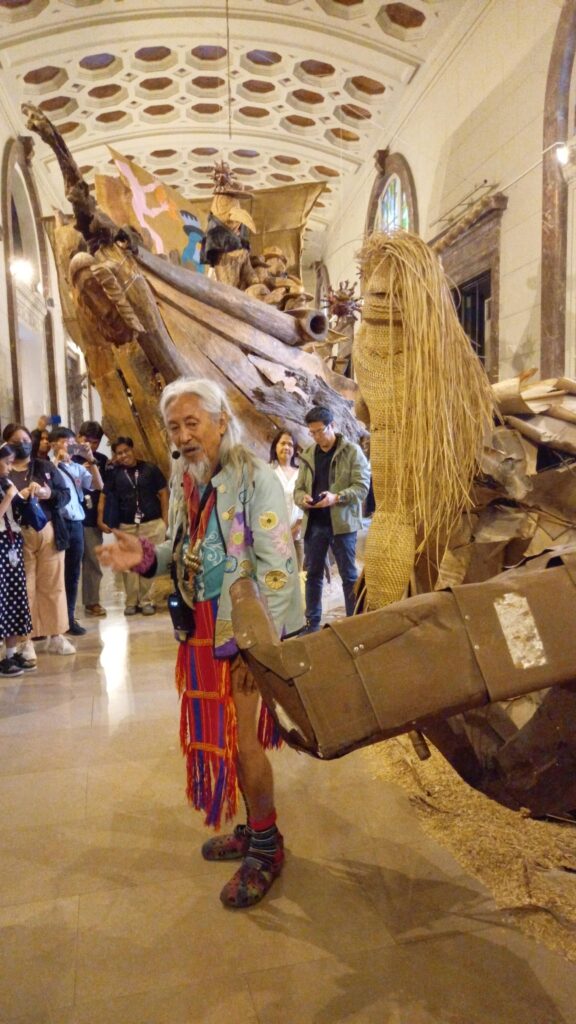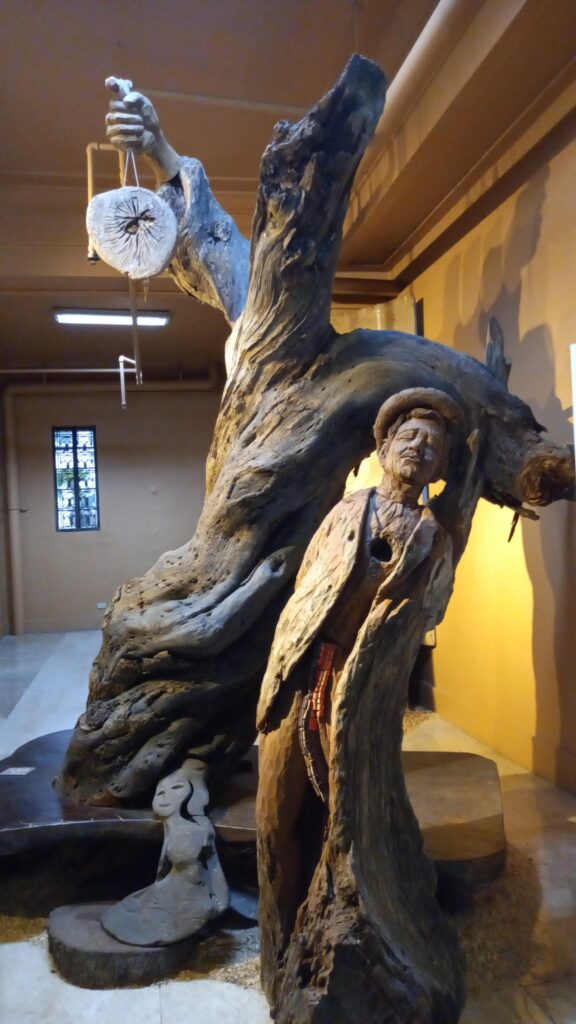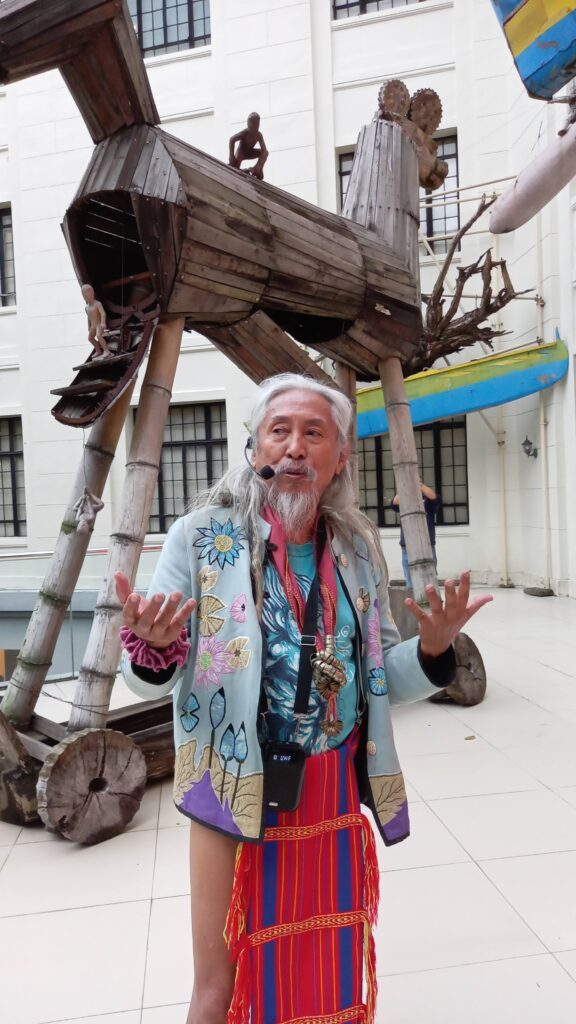In commemoration of Andres Bonifacio’s birth anniversary last 30 November, the National Museum of the Philippines hosted the premiere screening and special reception of the documentary film based on National Artist Kidlat Tahimik’s ongoing exhibition titled Indio-Genius: 500 Taon ng Labanang Kultural.
Tahimik himself graced the event, wearing the Ifugao bahag (loincloth), in appreciation of the film made by Gabriel Malvar for the online series Know Your North. It is an initiative of Victory Liner, Inc., a bus company that services routes mainly to the provinces of Central Luzon and Northern Luzon.
After the main program, which was held at the Gallery 1 of the National Museum of Anthropology in Manila, Tahimik gave a guided tour of the exhibition to the event’s attendees. He explained how each piece—whether it’s his own installation or an artwork contributed by either his wife Katrin de Guia or their children Kawayan and Kabunyan—relates to the theme of colonialism in Philippine history. He also emphasized the innate brilliance of Filipinos, thus the term indio-genius, as coined by his Ifugao mentor Lopes Na-Uyac.
The artist used as an example those who constructed the rice terraces that are found in Banaue and other towns in the mountainous province of Ifugao. He pointed out, “It’s nice to take a selfie at the rice terraces and say, ‘Ah, ito ang (it’s the) eighth wonder of the world.’ But beyond those labels, it really proves na we could solve our technological problems to provide food security. We could create a super irrigation system.”

Gender equality
Tahimik turned animated as he talked about the exhibition’s centerpiece: his interpretation of the Victoria ship and its Portuguese captain Ferdinand Magellan’s final moment as a casualty in the Battle of Mactan in 1521. In the artist’s reading of history, Magellan was defeated by the wife of Mactan’s chief Lapu-Lapu named Bulakna, who was an expert in the traditional martial arts, specifically arnis.
“Why not?” he told his attentive audience at the museum. “It’s possible that the last blow that knocked down Magellan was from a woman. I think the women here will appreciate it. Pero (But) I’m not doing it to please you. I really think ang lakas ng mga babae until today (the role of women in very strong). It’s a gender-equality victory for us.”
The artist also talked about the large Trojan horse-inspired installation and other pieces that bear references to Hollywood symbols and the indigenous Filipino icons. “This is about the continuing cultural battles,” he said. “Hollywood has been weakening our cultural defenses. We’ve always been mesmerized by stories that come from Hollywood, and what does it do? It makes us belittle our own stories.”
He then reached the last leg of the exhibition, showing Jose Rizal’s execution in Bagumbayan on 30 December, 1896. “Ang favorite ko dito (here) is the last moment of Rizal. He’s shot and his hat falls down,” he said of the sculpture of the National Hero, here wearing a bahag over his overcoat pants.
“These are all made of driftwood. These are natural tree na (that) I brought down from Baguio. As I’ve said, I always think of Rizal as one of the indio-genius of our country. In spite of him being Westernized, napakagaling ng kanyang (he had excellent) survival instincts, napakagaling ng kanyang adaptability, napakagaling ng kanyang human relations with any race. Therefore I think the indio-genius in him is something that outlived him.”

He added, “As I’ve said kanina we should stop believing na ang galing ni Rizal kasi ang galing niya magnobela sa Espanyol, marunong siyang mag-opera with Western medicine, marunong siyang gumawa ng engineering na irrigation system (As I’ve said earlier, we should stop believing that Rizal is exemplary because he’s excellent in writing novels in the Spanish language, that he knew who to operate using Western medicine, that he knew engineering and how to make an irrigation system).”
“The big question more is, why was he capable of adapting methods from other parts of the world. Because inside his overcoat, may bahag pa rin siya (he’s wearing a bahag). Anyone can debate, wala namang bahag sa (there’s no bahag in) Calamba,” he said, referring to Rizal’s hometown situated in Laguna province.
“But this is a metaphor lang (only). Because we always see Rizal in an overcoat—sa (in) Luneta [of Rizal Park], hindi ba (right)? When you go to any school, parating may rebulto si Rizal naka-Amerikana, naka-Western suit. (There’s always a statue of Rizal wearing a Western suit.) His Westernized self was part of the thing why he was accepted abroad.”
Tahimik’s Indio-Genius: 500 Taon ng Labanang Kultural will fittingly close at the National Museum of Anthropology on the last day of December this year, in commemoration of Rizal’s 127th death anniversary. It’s going to be over a year since the exhibition was brought home from its original launch in Madrid’s Palacio de Cristal del Retiro in Spain from October 2021 to March 2022.
